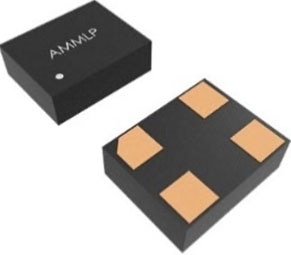Design Flexibility with Abracon's AMMLP MEMS Oscillators
In low-power electronics, the timing source is a hidden driver of battery life, reliability, and performance. For decades, quartz crystals were the standard timing element in electronics, until silicon-based micro-electro-mechanical systems (MEMS) oscillators emerged.
Selecting a MEMS oscillator is among the most impactful steps in designing applications ranging from wearables and IoT sensors to industrial and high-speed digital systems. Etched into silicon, they vibrate at precise frequencies to provide stable digital timing signals.
Quartz crystals, used since the 1930s, rely on piezoelectricity to vibrate at precise frequencies when voltage is applied. Naturally stable, they ensure reliable, long-term timing for devices such as microcontrollers and radios.
But quartz crystals are relatively fragile and are fixed to specific frequencies, making them problematic for design iterations and frequency customization. Moreover, they require milliseconds to stabilize after being powered on, so are ill-suited for low-power devices with frequent sleep cycles.
Electronic alternatives like resistor-capacitor (RC) oscillators and inductor-capacitor (LC) oscillators can generate a clock signal from electronic components, but may suffer frequency drift due to temperature, voltage, or age.
MEMS oscillators combine the mechanical stability characteristics of quartz with the miniaturization, shock resistance, and configurability of silicon. This makes them particularly suited for applications dependent on low power, ruggedness, or space constraints. They wake in microseconds, are stable across temperature swings, and feature low power draw, equating to longer run times, smaller batteries, and more compact and robust designs.
Shock-resistant, programmable options
Abracon offers a range of timing and frequency control devices, including the AMMLP series of MEMS oscillators that deliver highly precise frequency control in an ultra-compact, low-power package (Figure 1). Compared with traditional quartz, AMMLP devices are shock-resistant, ultra-compact, and programmable, offering engineers options to match exactly the frequency and footprint needs of their designs.
 Figure 1: Abracon's AMMLP series of MEMS oscillators is available in industry-standard package sizes and a broad range of frequency options. (Image source: Abracon)
Figure 1: Abracon's AMMLP series of MEMS oscillators is available in industry-standard package sizes and a broad range of frequency options. (Image source: Abracon)
From next-generation fitness trackers to autonomous drones, AMMLP oscillators deliver the precise, low-power timing that modern applications demand. Available in a versatile lineup with frequencies spanning 2.3 MHz to 170 MHz, the AMMLP devices balance precision, low power, and flexibility. They support four supply voltage options: 1.8 V, 2.5 V, 3.3 V, and a continuous range of 2.25 V to 3.6 V.
From a power standpoint, AMMLP oscillators are built for energy-conscious designs. Typical current draw is around 6.5 mA, and many models include standby or output-enable modes so devices can sleep without wasting energy. Available in industry-standard package sizes of 2.0 x 1.6 mm, 2.5 x 2.0 mm, 3.2 x 2.5 mm, 5.0 x 3.2 mm, and 7.0 x 5.0 mm, they provide drop-in ease of integration for even the most compact designs.
Frequency stability
The Abracon devices can be factory programmed for almost any frequency within their range. Tight frequency stability, with options of ±20 ppm to ±50 ppm across wide temperature ranges, ensures consistent timing for portable, industrial, or consumer applications.
The AMMLPAALJS-24.0000T is a 2.0 x 1.6 mm MEMS oscillator that saves PCB space while delivering a midrange 24 MHz frequency with precision and low power. It provides a stable clock signal for microcontrollers, wireless radios, and other digital circuits, running on a supply voltage of 2.25 V to 3.63 V. Maximum active current is 7.5 mA, while standby current is just 1.8 µA, making it ideal for battery-powered devices.
Slightly larger at 2.5 x 2.0 mm, the AMMLPDALJS-25.0000T operates at 25 MHz, a frequency often used in Ethernet, USB, and some wireless radios. With a typical standby current of just 1 µA, it also operates with the same flexible supply voltage range of 2.25 V to 3.63 V, ensuring energy-efficient operation in portable or industrial designs.
Also available in a 2.5 x 2.0 mm package and consuming 1 µA in standby, the 50 MHz AMMLPDDLJS-50.0000T supports a 1.8 V supply and draws up to 7.5 mA when active. Its compact size and low power consumption make it a strong choice when space and energy efficiency are paramount.
All three of these devices provide ±20 ppm frequency stability and CMOS output to simplify application design.
Conclusion
The AMMLP series are compatible with a broad spectrum of electronics, from wearables and IoT sensors to drones, robotics, and audio/video equipment. The frequency range, multiple package sizes, and supply voltage options provide designers with flexibility to select the precise oscillator to match the timing, power, and space requirements of virtually any application. When every extra milliamp counts and every millimeter of PCB space matters, AMMLP MEMS oscillators provide designers with the headroom to innovate without compromise.

Have questions or comments? Continue the conversation on TechForum, DigiKey's online community and technical resource.
Visit TechForum








